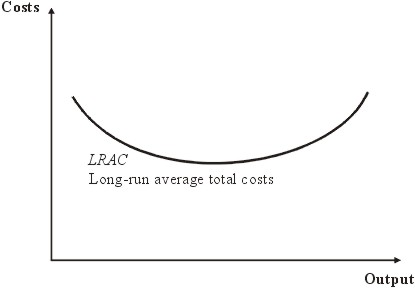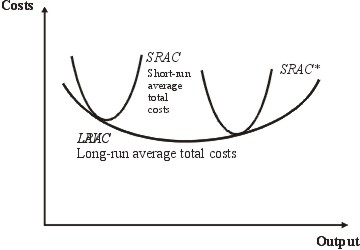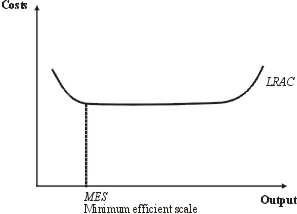|
Market Structures |
Big firms and little firms |
|
A market is any arrangement whereby buyers and sellers communicate with each other in order to exchange goods and services. Each individual market is defined by goods or services that are homogeneous to an extent — in other words, of the same type, and satisfying the same needs. For example, one banana is pretty much the same as another. The goods or services available in a market are almost exact substitutes for each other. On the other hand, sometimes there exist substitutes for a product that are not exact. For example, wood can sometimes be substituted for coal as a source of fuel for open-hearth fires. They are not exact substitutes for each other, but they are near substitutes. The existence of substitutes makes the “boundaries” of a market somewhat fuzzy.
|
|
|
A firm is a unit of business that takes factor inputs (land, labour and capital) and transforms them into another product, adding value as it does so. Each firm provides goods and/or services to a market. A collection of firms supplying the same market is an industry.
|
|
|
Firms in the same industry compete with one another.
|
|
|
Sometimes firms are big and sometimes little; sometimes the competition within an industry is intense, and sometimes not so intense. Therefore, it is relevant to ask, what is it that determines whether the firms in an industry are large or small, and what determines the extent of rivalry between firms?
|
|
Porter's Five Forces Model |
|
The number of firms in a market and the degree to which those firms set and control their own prices is called a market structure.
|
|
|
The question is what determines the market structure of an industry?
|
|
|
Actually, it is possible to ask and answer this question from two related points-of-view — firstly, from the point-of-view of a business in the industry, and secondly from the point-of-view of an economist who is trying to understand the structure of the industry and is not concerned with the fate and fortunes of one particular business.
|
|
|
The business point-of-view has been effectively analysed by Michael Porter in his five forces model. This model is dealt with in another chapter, and is concerned with determining the conditions under which a firm in an industry finds it more or less easy to make a profit.
|
|
|
In examining the question from an economist's point-of-view, we shall first describe the spectrum of market structures that can exist in an industry.
|
|
The spectrum of competition |
|
Economists identify the following broad classifications of market structure.
|
|
|
Perfect competition
|
|
|
There are many firms in an industry, and none of them is significantly larger than another. Each firm produces only a tiny proportion of the total output of the industry. The goods are almost exact substitutes for each other. The market as a whole determines (through the price determination mechanism) the price of the good and the quantity supplied by the industry as a whole to the market. The firms in the industry are price takers because they have to accept (“take”) the price that is determined by the market, and have no control over that price.
|
|
|
An example of perfect competition might be greengrocers in a large covered market. There may be fifty such greengrocers all selling almost identical (homogeneous) products. Each greengrocer must sell its products for almost identical prices to the other greengrocers and it is the market as a whole (interaction of market supply and market demand) that determines that price. If a greengrocer in isolation from the other greengrocers raises his prices he will sell nothing.
|
|
|
Imperfect competition
|
|
|
All other forms of market structure are called “imperfect competition”, but there are several distinct types.
|
|
|
Monopoly
|
|
|
In an exact monopoly there is just one firm in the industry. Only one product is produced and that by just one firm. Since there is only one firm in the market, the product produced is unique — there is only one product. All products are homogeneous. Demand for the company's product is identical to the demand for the product in the market. Therefore, the producer has control over the price at which the product is sold and the quantity sold.
|
|
|
An example of a monopoly is a regional water company. Within a geographical region there is only one supplier of water.
|
|
|
A water company is an example of a natural monopoly. It is a “natural” monopoly because the nature of the geography of a region means that there can be only one supplier of water. The monopoly is made by natural forces (or barriers to entry, which we will discuss below).
|
|
|
Product differentiation
|
|
|
We have seen that products supplied to a market need to be substitutes for each other. However, sometimes these substitutes are exact, and sometimes they are not. An example of a market comprising inexact substitutes is the car market. One car is more or less a substitute for another, but cars differ from each other in many significant ways. In fact, the differences between cars are so great that the car market as a whole might be regarded as divided up into several smaller markets. For example, there is the market for jeeps (land-rovers) and there is the luxury sports car market. Within each of these market segments there are also products that differ from one another. One jeep is not identical to another.
|
|
|
Where the products supplied to a market are all exact substitutes for each other, then those products are said to be homogeneous. Markets where the products are non-homogeneous are said to be differentiated markets. The products are differentiated from each other.
|
|
|
Armed with this concept we can now describe another kind of imperfect market structure.
|
|
|
Oligopoly
|
|
|
An oligopoly exists when there are just a few large firms supplying goods to a market.
|
|
|
It is usual for oligopolies to supply differentiated products. The market for air travel gives an example. The products (air flights) are quite close substitutes, but there are some differences between flights on one airline and flights on another in terms of quality of service, style, kinds of food offered and so forth.
|
|
|
Oligopolies can exist where the products are homogeneous. For example, the provision of units of electricity by different power generators. A kilowatt hour of electrical energy supplied by one producer is homogeneous with a kilowatt hour of electrical energy supplied by another.
|
|
|
Firms competing in an oligopolistic market structure do have a measure of control over the prices they sell at and the quantity they produce. Because of their size they face downward sloping demand curves and this means that they can choose to an extent how much to produce and what price to produce at.
|
|
|
Barriers to entry
|
|
|
Barriers to entry are concerned with how easy it for firms not in an industry to enter the industry. For example, a firm that manufactures machine tools might decide to manufacture detergents. The question is, how difficult would it be for a firm to make this decision? The “greater” the barriers to entry the more difficult it is to enter the market. A barrier is as it sounds — a kind of hurdle that has to be jumped over. The bigger the hurdle the fewer the firms that can “jump” it.
|
|
|
In a moment we shall describe what causes barriers to entry; for the present we can describe another form of imperfect market structure.
|
|
| Monopolistic competition
|
|
|
This is a market structure where there can exist (for reasons described below) only a small number of firms, but the barriers to entry are “low” so that other firms can enter the market.
|
|
|
An example that is often cited is the manufacture of detergent. The technology involved in manufacturing detergent is not that sophisticated. Clearly, a company does require access to capital in order to establish a production facility, but many companies do have that kind of access. So it is relatively easy for one company not already producing detergent to enter the market and “raid” it.
|
|
|
The implication of this is that firms already in a market with a structure of monopolistic competition are faced with the constant threat of other firms entering it and raiding it. This means that they have to be much more competitive over prices than they would be if the industry was a simple oligopoly.
|
|
|
The companies tend to be smaller than those in an oligopoly. The classic model of monopolistic competition states that this industry structure is determined by (1) many firms (2) offering differentiated products (3) where there are low barriers to entry. Other examples, include hardware retailing and restaurants.
|
|
Economies and diseconomies of scale |
|
The next question we have to ask is this: what determines the size of a firm in an industry?
|
|
|
The first answer is that it is the minimum efficient scale that determines this, and we seek now to explain what this means.
As companies get larger they become more efficient at producing goods and services. This is because there are returns to scale. There are three kinds of returns to scale: technical, returns due to specialization, and purchasing.
|
|
|
Technical Returns to scale
|
|
|
Technical returns to scale occur because businesses can use mass production techniques.
|
|
|
Indivisibilties. Certain productive techniques can only be used if output is large enough. For example, bottle capping machines have a smallest size. It is only worthwhile to apply certain production techniques if output exceeds a minimum level dictated by the capacity of a particular technique. Inputs other than capital can be indivisible — for example, a single general manager.
|
|
|
Increased dimensions. A special kind of indivisibility arises from the increased size of an object. For example, the capacity of a container increases more than proportionately to the quantity of material used in its construction.
|
|
|
Indivisibilities resulting in increased returns to scale. Constant and diminishing returns to scale arise because (1) larger machines may be efficient up to a point but larger and larger machines need not always be more efficient. (2) Large management structures are less efficient generally.
|
|
|
Specialization
|
|
|
When firms expand it is possible for greater specialization of the workforce. This creates more efficiency, so average total costs fall.
|
|
|
Purchasing
|
|
|
When firms expand they buy in bigger bulk from suppliers. The suppliers offer discounts and better terms, so average total costs fall.
|
|
|
Diseconomies of Scale
|
|
|
However, when companies get very large then they become less efficient. this is because they become more bureaucratic, hence leading to (1) difficulties of communication; (2) difficulties in co-ordinating the business as a whole; (3) difficulties in controlling the workforce; (4) difficulties in motivating people in a large organisation.
|
|
The Long-run average total cost curve |
|
The long-run average total cost curve is expected to show a fall, as production quantity increases, and then rise.
|
|

|
|
|
Long run average cost curve
|
|
|
This is for the following reasons. Initially, as the scale is increased the firm experiences increasing returns to scale. Efficiency improves owing to technical economies, managerial economies, purchasing and marketing economies and financial economies. Thereafter, diseconomies of scale set in. This is principally because after a certain level the company becomes bureaucratic, and this introduces inefficiency.
|
|
|
In the long-run all factors of production can vary. Consequently, firms can scale up or scale down. The long-run average total cost curve exhibits the same characteristics as the short-run curve — that is, long-run average costs first fall and then rise.
|
|
|
The short-run average cost curves are “tangental” to the long-run average cost curve. The term “tangental” means that the short-run average cost curves just “touch” the long-run curve.
|
|

|
|
|
Short and long-run average cost curves
|
|
|
However, in the very long-run technology can change and the LRAC can alter in an unknown and unpredictable way.
|
|
Minimum efficient scale
|
|
The minimum efficient scale is defined to be the first point on the LRAC (long-run average cost) curve.
|
|

|
|
|
A “flat-bottomed” long-run average cost curve
|
|
|
This graph is also drawn to illustrate the idea that the LRAC is often “flat-bottomed”. This means that there is a range of sizes of firm at which there is maximum efficiency. The minimum efficient scale is the smallest firm at which this maximum efficiency is obtained.
|
|
|
It is the MES (minimum efficient scale) that determines the structure of an industry. To show why, suppose, for example, that the market requires an output from the industry of 100 units of a given product. Suppose that the MES is at 20 units. Then this implies that the industry will be an oligopoly with 100/20 = 5 competing firms.
|
|
|
If the LRAC was “flat-bottomed” then the industry would be highly competitive; because that would mean that each of the 5 competing firms could increase profit by increasing output,
|
|
|
On the other hand, suppose the market requires an output of 10,000 units and the MES is just 1 unit. Then there would be 10,000 firms each producing just one unit, and the industry would be in perfect competition.
|
|
|
So it is the minimum efficient scale that determines the basic structure of the market. The larger the MES (minimum efficient scale) the closer the industry structure to monopoly becomes.
|
|
Barriers to Entry |
|
A barrier to entry is a factor that makes it difficult for a company outside the industry to enter the industry. When there are low barriers to entry, then it is always possible for new firms to enter, and this increases competitiveness within the industry. The common barriers to entry are
|
|
| 1 | | Economies of scale. When firms become larger, they experience lower average costs. It is not easy for a small firm to enter the market.
|
| 2 | | The “learning curve”. Success in the industry depends on experience gained from being in the business. It is not easy for a new entrant to replicate this experience. |
| 3 | | Branding. When existing firms in the industry have well-developed brand names, it is not easy for new entrants to win customers from these existing firms. |
| 4 | | Capital. When the capital requirements of entering the industry are very high, only companies with access to sufficient capital can create a new company and compete. |
| 5 | | Cost advantages that do not depend on size. Some companies may have access to advantages that do not depend on economies of scale. For example, they may be closely situated near a raw material. |
| 6 | | Distribution channels. Some companies cannot reach the customer effectively because the existing firms have control over the distribution channels. |
| 7 | | Government policies. Government legislation and policy can create barriers to entry. Governments may create tariff barriers around their country. Patents and copyrights prevent one company from replicating the material of another. |
|
|
|
One can see from this that it is not only the minimum efficient scale that determines the structure of the market. The minimum efficient scale is itself determined by economies of scale, and this is the prime example of a barrier to entry. Another type of barrier to entry can transform a market from one kind of structure to another. For example, a patent to produce a drug turns a market from an oligopoly into a monopoly. Here a legal barrier to entry creates a monopoly. In general, the lower the barriers to entry, the greater the competitiveness of the industry, and the greater the threats posed to firms already operating in that industry.
|
|